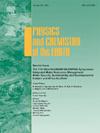沿海多层含水层的氟化物富集和水文地球化学特征:对公众健康和营养的影响
IF 3
3区 地球科学
Q2 GEOSCIENCES, MULTIDISCIPLINARY
引用次数: 0
摘要
沿海淡水对饮用水需求至关重要,但由于盐水入侵和人类在世界各地许多热带人为改造海岸的投入,其稀缺性正在增加。然而,在包括孟加拉国在内的一些地区,地下水质量尚未就氟化物污染、其水文地球化学性质、对人类健康的影响和营养动态进行广泛研究。本研究旨在评估孟加拉国考克斯巴扎尔经改造的热带海岸沿线多个含水层的氟化物富集和广泛的水文地球化学特性。对浅层(SA)、中含水层(MA)和深层含水层(DA)共91份地下水样品进行了水文地球化学元素分析。结果显示,29%、25%和27%的SA、MA和DA样品的氟化物浓度超过允许限值(1.50 mg/L),最高浓度为13.5 mg/L。饱和指数表明,蒸发加剧了40%以上地下水样品的氟富集,与总溶解固形物(TDS)增加相一致。氟在SA体系中的富集可归因于蒸发岩溶解、碳酸盐风化、解吸、竞争吸附、阳离子交换和矿物溶解-沉淀过程。稳定同位素分析表明,补给过程中MA水不受蒸发影响,而近期补给事件主要通过降雨入渗影响SA和DA水的同位素组成。熵水质指数分别将87.4%、91.8%和82.9%的SA、MA和DA地下水样本划分为极差水质。健康风险评估显示,SA具有最高的非致癌风险(83.02%),其次是MA(12.03%)和DA(9.75%)。使用南非水的成年人面临的健康风险是儿童的五倍,北部地区被确定为营养风险的热点地区。每日饮水增加了健康风险,尤其是在成年人中。研究结果强调,迫切需要可持续的地下水管理战略,以确保热带、人为改变的沿海地区的安全饮用水供应。本文章由计算机程序翻译,如有差异,请以英文原文为准。

Fluoride enrichment and hydrogeochemical characteristics in coastal multi-aquifers: Implications for public health and nutrition
Coastal freshwater is essential for drinking water needs, but its scarcity is increasing due to saltwater intrusion and human inputs in many tropical anthropogenically modified coasts around the worldwide. However, in some areas, including Bangladesh, groundwater quality has not been extensively studied concerning fluoride contamination, its hydrogeochemical properties, human health impacts, and nutrient dynamics. The present study aimed to assess the fluoride enrichment and broad hydrogeochemical properties of multiple aquifers along the modified tropical coast of Cox's Bazar, Bangladesh. A total of 91 groundwater samples from shallow aquifers (SA), middle aquifers (MA), and deep aquifers (DA) were analyzed for hydrogeochemical elements. The results revealed that fluoride concentrations exceeded the permissible limit (1.50 mg/L) in 29 %, 25 %, and 27 % of SA, MA, and DA samples, with a maximum concentration of 13.5 mg/L. The saturation index indicated that evaporation intensified fluoride enrichment in over 40 % of groundwater samples, coinciding with increased total dissolved solids (TDS). The fluoride enrichment in the SA system was attributed to evaporite dissolution, carbonate weathering, desorption, competitive adsorption, cation exchange, and mineral dissolution-precipitation processes. Stable isotope analysis suggested that MA water was unaffected by evaporation during recharge, while recent recharge events influenced the isotopic composition of SA and DA waters, primarily through rainfall infiltration. The entropy water quality index classified 87.4 %, 91.8 %, and 82.9 % of respective SA, MA, and DA groundwater samples as very poor in quality. Health risk assessment revealed that SA posed the highest non-carcinogenic risk (83.02 %), followed by MA (12.03 %) and DA (9.75 %). Adults using SA water faced five times higher health risks than children, with the northern region identified as a hotspot for nutritional risks. Daily water intake exacerbated the health risks, particularly among adults. The findings emphasize the urgent need for sustainable groundwater management strategies to ensure safe drinking water supplies in tropical, anthropogenically altered coastal regions.
求助全文
通过发布文献求助,成功后即可免费获取论文全文。
去求助
来源期刊

Physics and Chemistry of the Earth
地学-地球科学综合
CiteScore
5.40
自引率
2.70%
发文量
176
审稿时长
31.6 weeks
期刊介绍:
Physics and Chemistry of the Earth is an international interdisciplinary journal for the rapid publication of collections of refereed communications in separate thematic issues, either stemming from scientific meetings, or, especially compiled for the occasion. There is no restriction on the length of articles published in the journal. Physics and Chemistry of the Earth incorporates the separate Parts A, B and C which existed until the end of 2001.
Please note: the Editors are unable to consider submissions that are not invited or linked to a thematic issue. Please do not submit unsolicited papers.
The journal covers the following subject areas:
-Solid Earth and Geodesy:
(geology, geochemistry, tectonophysics, seismology, volcanology, palaeomagnetism and rock magnetism, electromagnetism and potential fields, marine and environmental geosciences as well as geodesy).
-Hydrology, Oceans and Atmosphere:
(hydrology and water resources research, engineering and management, oceanography and oceanic chemistry, shelf, sea, lake and river sciences, meteorology and atmospheric sciences incl. chemistry as well as climatology and glaciology).
-Solar-Terrestrial and Planetary Science:
(solar, heliospheric and solar-planetary sciences, geology, geophysics and atmospheric sciences of planets, satellites and small bodies as well as cosmochemistry and exobiology).
 求助内容:
求助内容: 应助结果提醒方式:
应助结果提醒方式:


